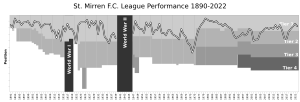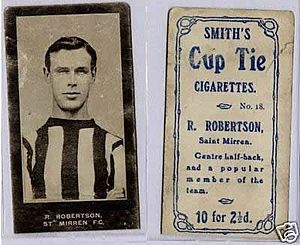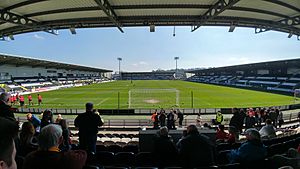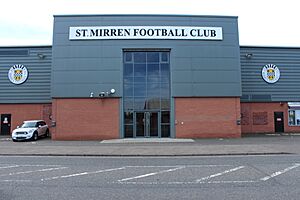St Mirren F.C. facts for kids
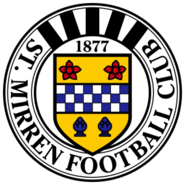 |
|||
| Full name | St Mirren Football Club | ||
|---|---|---|---|
| Nickname(s) | The Buddies The Saints |
||
| Founded | 1877 | ||
| Ground | St Mirren Park, Paisley | ||
| Capacity | 7,937 | ||
| Chairman | John Needham | ||
| Manager | Stephen Robinson | ||
| League | Scottish Championship | ||
| 2015–16 | Scottish Championship, 6th | ||
|
|
|||
St Mirren Football Club is a professional football team from Scottish city of Paisley, Renfrewshire. The club was started in 1877. They are often called The Buddies or The Saints. St Mirren plays in the Scottish Championship league. They won the 2017–18 Scottish Championship to get there.
St Mirren has won the Scottish Cup three times: in 1926, 1959, and 1987. They also won the Scottish League Cup in 2013. The team has played in European competitions five times. This includes the UEFA Cup Winners' Cup in 1987–88 and the UEFA Cup in 1980–81, 1983–84, and 1985–86. In 2024–25, they returned to Europe for the first time in 37 years to play in the 2024–25 UEFA Conference League. St Mirren is the only Scottish team to win the Anglo-Scottish Cup. They beat Bristol City 5–1 in 1979–80.
Since 2009, the club's home ground has been St Mirren Park. It is an all-seater stadium in Paisley with room for 7,937 fans. Before 2009, their home was also called St Mirren Park. But most people knew it as Love Street.
Contents
Club History
St Mirren Football Club started as a gentlemen's club in the 1800s. Members played sports like cricket and rugby. As football became more popular, they decided to form a football club in 1877. This is why 1877 is the club's official start date. The club is named after Saint Mirin. He founded a church near Paisley Abbey and is the patron saint of Paisley.
The team's first uniform was scarlet and blue. After one season, they changed to black and white striped shirts. They have worn these colors almost every season since. Only once in the 1900s did they use cream-colored tops.
Early Matches and Moves
St Mirren played their first game on October 6, 1877. They beat Johnstone Britannia 1–0 at a place called Shortroods. Two years later, the club moved to Thistle Park. St Mirren's first Scottish Cup game was on September 4, 1880. They won 3–0 against Johnstone Athletic.
In 1881, St Mirren reached their first cup final, the Renfrewshire Cup. They lost 3–1 to Thornliebank. But in 1883, they won the Renfrewshire Cup, beating Thornliebank 3–1. That same year, the club moved to its third home, West March. They played their first game there against Queen's Park. In 1885, St Mirren played their first match against their rivals, Morton.
Joining the Scottish Football League
The 1890 season was a big one for St Mirren. They became one of the first teams to join the Scottish Football League. Another Paisley club, Abercorn, also joined. Out of the eleven original clubs, only five are still in the league today. In 1890, St Mirren played one of the first night games under oil lamps. This happened during a match against Morton.
The club moved to Love Street in 1894. The team reached their first Scottish Cup final in the 1907–08 season. They lost 5–1 to Celtic. St Mirren later won the Scottish Cup in 1926, 1959, and 1987.
In 1922, St Mirren was invited to play in the Barcelona Cup. This tournament celebrated the opening of Camp de Les Corts, which was then the home of Barcelona. St Mirren won the tournament by beating Notts County in the final.
European Adventures and Recent Success
In the 1979–80 season, St Mirren finished third in the top league. This was their highest-ever finish. They were behind Aberdeen and Celtic. That season, the Saints also became the first and only Scottish club to win the Anglo-Scottish Cup. They beat Bristol City in a two-game final.
The next season, St Mirren played in Europe for the first time. They won their first game 2–1 against IF Elfsborg in Sweden. The next round, they played French team Saint-Étienne. St Mirren drew 0–0 at home, but Saint-Étienne won 2–0 in the second game. This put St Mirren out of the cup.
The club has been moved down from the Scottish Premier League twice (in 2001 and 2015). They also moved down from the Premier Division of the Scottish Football League once (in 1992). In 2001, St Mirren finished last in the Premier League. However, they earned promotion back up in 2006. That season, they also won the Scottish Challenge Cup. They beat Hamilton Academical 2–1 in the final.
In 2010, St Mirren reached the final of the Scottish League Cup. They lost 0–1 to Rangers. However, a few days later, they had a famous 4–0 win over Celtic. In March 2013, St Mirren won the Scottish League Cup. They beat Heart of Midlothian 3–2 at Hampden Park. This was their first cup win since 1987.
In the 2010s, the club was praised for its youth development. They helped many young players from their academy become professional footballers. Some of these players include Kenny McLean, Lewis Morgan, and John McGinn. These players went on to play for the full Scotland national team.
St Mirren Park Stadium
St Mirren played at four different places before moving to Love Street in 1894. The most people ever to watch a game at Love Street was 47,438. This was for a match against Celtic in 1949. Love Street was updated in the late 1990s. It became a stadium with 10,866 seats.
In 2005, Renfrewshire Council allowed the club to sell their old ground. This allowed them to build a new stadium in Paisley. The sale of Love Street helped the club pay for the new stadium and clear their debts. On January 15, 2009, St Mirren moved to a new 8,000-seat stadium. It was also named St Mirren Park.
The first game at the new stadium was a 1–1 draw with Kilmarnock. The stadium's seating capacity was 8,023. In 2017, it was reduced to 7,937 to add a new disabled access area. The stadium was known as The Simple Digital Arena for a few years. It is currently called The SMiSA Stadium.
Team Colors and Sponsors
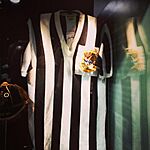
St Mirren's home colors are black and white stripes. However, for their very first season, they wore scarlet and blue. There are different ideas about why black and white were chosen. One popular idea is that the stripes represent the Black and White Cart rivers in Paisley. Another idea is that monks in the local abbey wore black and white striped robes. The team's uniforms have not changed much over the years. However, the width of the stripes has varied. Some years, they even used horizontal stripes.
St Mirren was the first club in the world to play in black and white vertical stripes in 1884. This was six years before Notts County.
Away uniforms are usually red or all black. But sometimes, they have been orange or light blue. For example, the 2010–11 uniform was light blue. The club has had different kit makers over the years. Currently, their kits are made by Macron.
St Mirren has had several main sponsors. Many of these have been from the transport industry. Local bus companies and car dealerships like Arriva and Phoenix Honda have sponsored the club. From 2005 to 2017, Braehead Shopping Centre was a sponsor. Currently, Consilium Contracting Services sponsors the team.
Club Mascots
St Mirren has three mascots, who are all pandas. Their names are Paisley Panda, Junior P, and Mrs Panda. Paisley Panda and Junior P are the regular mascots.
Team Rivalries
St Mirren has a strong rivalry with their nearby team, Greenock Morton. There is a lot of excitement between the fans of both teams during their matches.
Club Records
Here are some of St Mirren's impressive club records:
- Highest home attendance: 47,438 fans against Celtic on August 20, 1949.
- Biggest victory: 15–0 against Glasgow University in the Scottish Cup on January 30, 1960.
- Most games played for Scotland: Iain Munro and Billy Thomson, with 7 appearances each.
- Most games played for their country (non-Scotland): Mo Camara, with 79 appearances for Guinea.
- Youngest player: Dylan Reid, who played at 16 years and 6 days old against Rangers on March 6, 2021.
- Most competitive appearances: Hugh Murray, who played 462 games from 1997 to 2012.
- Most league goals: David McCrae, with 221 goals from 1923 to 1934.
- Most league goals in one season: Dunky Walker, with 45 goals in 1921–22.
- Record transfer fee paid: £400,000 for Thomas Stickroth in March 1990.
- Record transfer fee received: £850,000 from Rangers for Ian Ferguson in February 1988.
- Longest unbeaten league run: 34 games, from November 1967 to November 1968.
Current Players
First-team Squad
|
|
Players on Loan
|
|
Club Staff
Coaching Team
| Name | Role |
|---|---|
| Stephen Robinson | Manager |
| Brian Kerr | Assistant manager |
| Jamie Langfield | Goalkeeping coach |
| Peter Hartley | Head of first team transition and loan pathways |
| Allan McManus | Head of academy |
| Craig McLeish | U19 Coach |
| Scott Galloway | Head of academy coaching |
| John Park | Head of recruitment and emerging talent |
| Ross Horsburgh | Head of analysis |
| Gerry Docherty | Head of physiotherapy |
| Gary McColl | Head of sports science |
| Tommy Docherty | Groundsman |
| Joe Hayes | Kitman |
Board of Directors
| Name | Role |
|---|---|
| John Needham | Chairman |
| Jim Gillespie | Vice-chairman |
| Jim Irvine | Director |
| Mark MacMillan | Director |
| Paul McNeill | Director |
| Alex White | Director |
| Gordon Graham | Secretary |
| Keith Lasley | Chief operating officer |
| Tony Fitzpatrick | Club ambassador |
Team Managers
- John McCartney (1904 – 1910)
- Hugh Law (1910 – 1916)
- Johnny Cochrane (1916 – 1928)
- John Morrison (1929 – 1936)
- Bobby Rankin (1945 – 1954)
- Willie Reid (1954 – 1961)
- Alex Ferguson (1974 – 1978)
- Jim Clunie (1978 – 1980)
- Alex Miller (1983 – 1986)
- Alex Smith (1986 – 1988)
- Tony Fitzpatrick (1988 – 1991)
- Tony Fitzpatrick (1996 – 1998)
- Gus MacPherson (2003 – 2010)
- Danny Lennon (2010 – 2014)
- Jack Ross (2016 – 2018)
- Jim Goodwin (2019 – 2022)
- Stephen Robinson (2022 – present)
European Games
St Mirren has played in several European competitions. Here's a look at some of their matches:
| Season | Competition | Round | Opponent | Home Score | Away Score | Total Score |
|---|---|---|---|---|---|---|
| 1980–81 | UEFA Cup | First round | 0–0 | 2–1 | 2–1 | |
| Second round | 0–0 | 0–2 | 0–2 | |||
| 1983–84 | UEFA Cup | First round | 0–1 | 0–2 | 0–3 | |
| 1985–86 | UEFA Cup | First round | 3–0 (a.e.t.) | 0–1 | 3–1 | |
| Second round | 1–2 | 3–3 | 4–5 | |||
| 1987–88 | UEFA Cup Winners' Cup | First round | 1–0 | 0–0 | 1–0 | |
| Second round | 0–2 | 0–0 | 0–2 | |||
| 2024–25 | UEFA Conference League | Second qualifying round | 4–1 | 0–0 | 4–1 | |
| Third qualifying round | 1–1 | 1–3 | 2–4 |
Club Trophies
Major Wins
- Scottish Cup:
- Winners (3): 1926, 1959, 1987
- Runners-up: 1908, 1934, 1962
- Scottish League Cup:
- Winners (1): 2013
- Runners-up: 1956, 2010
Other Trophies
- Scottish league, second tier (5): 1968, 1977, 2000, 2006, 2018
- Scottish Challenge Cup: 2005
- Renfrewshire Cup (55): St Mirren has won this local cup many times, including recently in 2015.
- Anglo-Scottish Cup: 1980
- Barcelona Cup Winners: 1922
See also
 In Spanish: St. Mirren Football Club para niños
In Spanish: St. Mirren Football Club para niños


